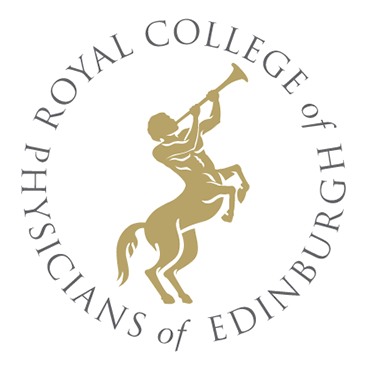
The Consultation Letters of Dr William Cullen (1710-1790) at the Royal College of Physicians of Edinburgh
[ID:4160] From: Dr William Cullen (Professor Cullen) / To: Dr Matthew Dobson / Regarding: Mr (Patient), Anonymous (Patient), Anonymous (Patient), Anonymous (Patient) / October? 1777? / (Outgoing)
Reply to 'Dr Dobson of Liverpool'. Cullen discusses the relationship between the catarrhus vesicae and the gout and refers to his own First Lines.
- Facsimile
- Normalized Text
- Diplomatic Text
- Metadata
- Case
- People
- Places
Facsimile
There are 4 images for this document.
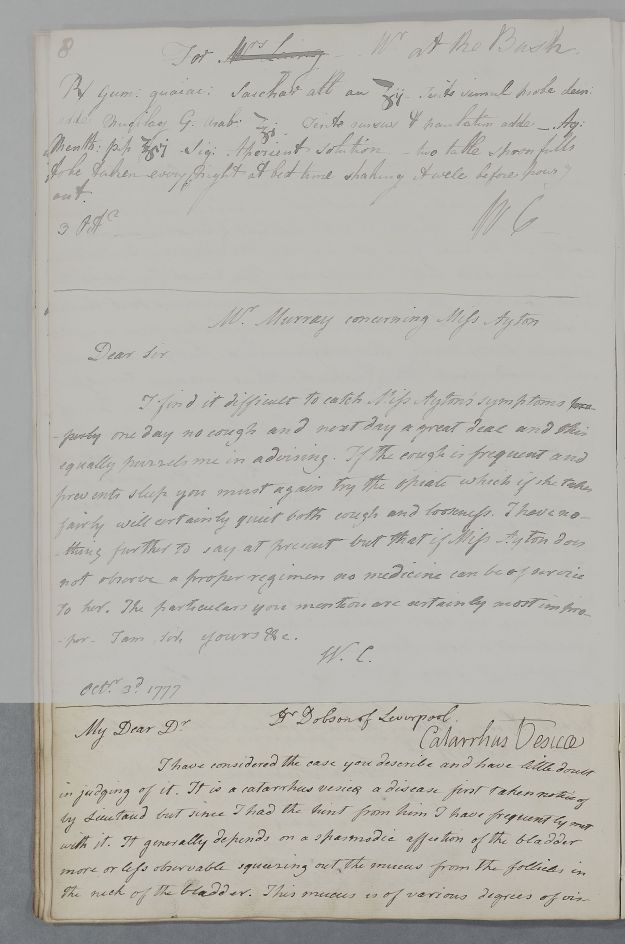
[Page 1]
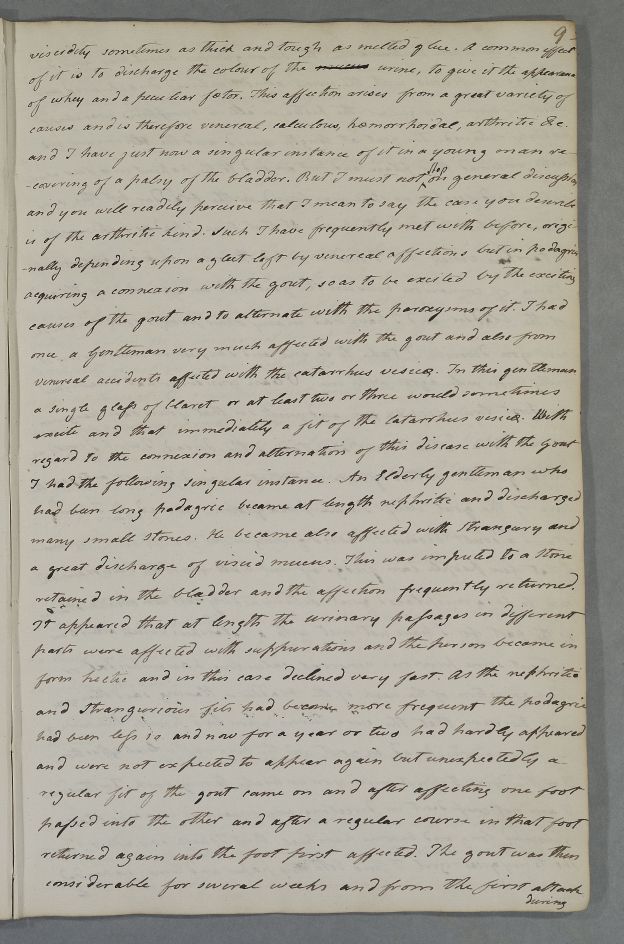
[Page 2]
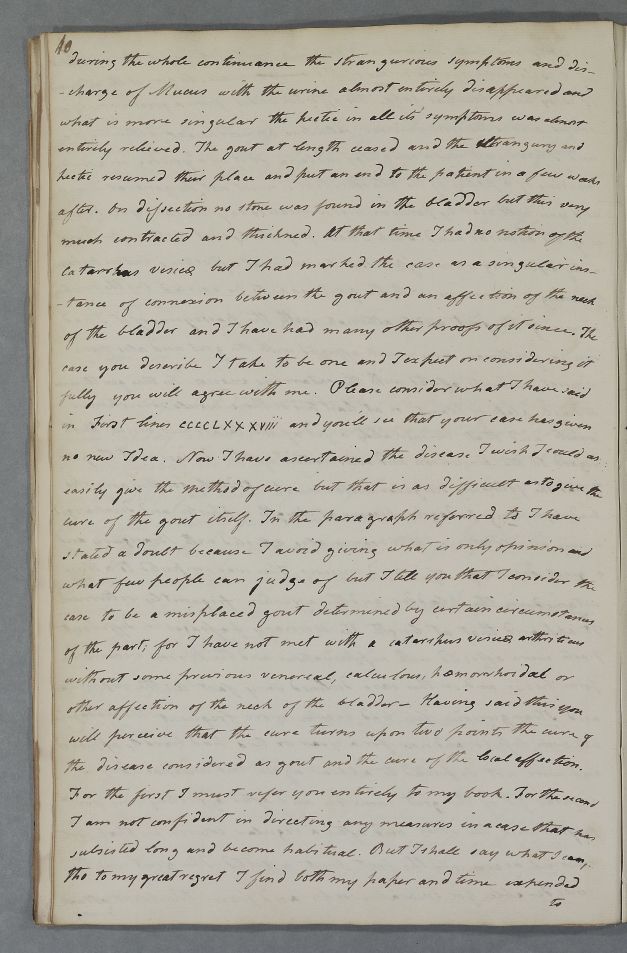
[Page 3]
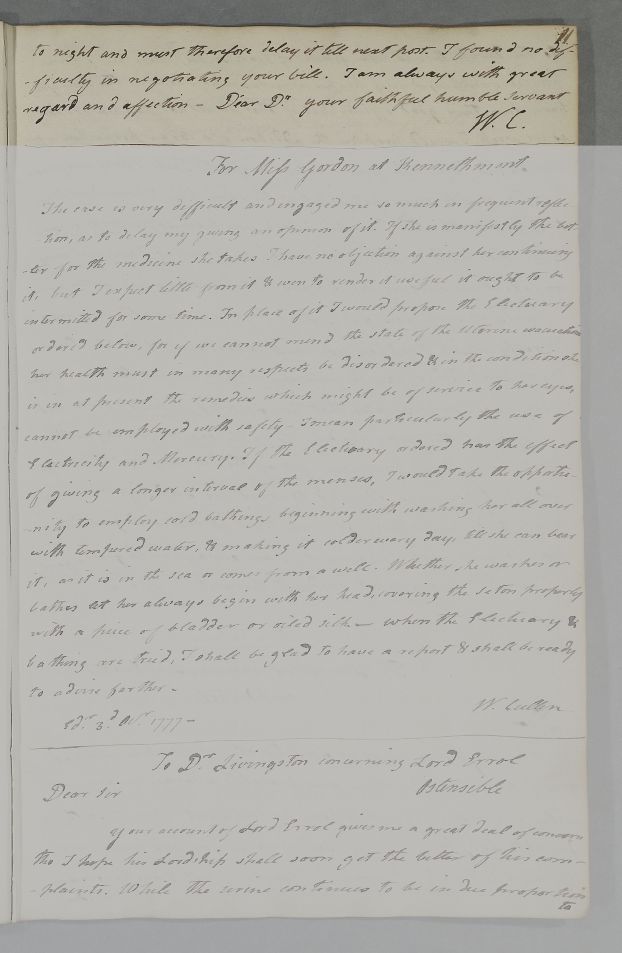
[Page 4]
Metadata
| Field | Data |
|---|---|
| DOC ID | 4160 |
| RCPE Catalogue Number | CUL/1/1/10/17 |
| Main Language | English |
| Document Direction | Outgoing |
| Date | October? 1777? |
| Annotation | None |
| Type | Scribal copy ( includes Casebook Entry) |
| Enclosure(s) | No enclosure(s) |
| Autopsy | No |
| Recipe | No |
| Regimen | No |
| Letter of Introduction | No |
| Case Note | No |
| Summary | Reply to 'Dr Dobson of Liverpool'. Cullen discusses the relationship between the catarrhus vesicae and the gout and refers to his own First Lines. |
| Manuscript Incomplete? | No |
| Evidence of Commercial Posting | No |
Case
Cases that this document belongs to:
| Case ID | Description | Num Docs |
|---|---|---|
| [Case ID:885] |
Case of an unnamed male patient of Dr Dobson's at Liverpool who has a gleet which Cullen considers stems from a very particular form of bladder irritation upon which he theorises. |
3 |
| [Case ID:2509] |
Case of "a Gentleman very much affected with the gout and also from venereal accidents affected with the catarrhus vesicae". |
1 |
| [Case ID:2510] |
Case of 'An Elderly gentleman who has been long podagric' who 'became at length nephritic and discharged many small stones. He became also affected with Stranguary and a great discharge of viscid mucus'. |
1 |
| [Case ID:2511] |
Case of a "young man recovering from palsy of the bladder". |
1 |
People linked to this document
| Person ID | Role in document | Person |
|---|---|---|
| [PERS ID:1] | Author | Dr William Cullen (Professor Cullen) |
| [PERS ID:469] | Addressee | Dr Matthew Dobson |
| [PERS ID:2125] | Patient | Mr |
| [PERS ID:2387] | Patient | |
| [PERS ID:2388] | Patient | |
| [PERS ID:2389] | Patient | |
| [PERS ID:1] | Patient's Physician / Surgeon / Apothecary | Dr William Cullen (Professor Cullen) |
| [PERS ID:469] | Patient's Physician / Surgeon / Apothecary | Dr Matthew Dobson |
| [PERS ID:1201] | Other Physician / Surgeon | Dr Joseph Lieutaud |
Places linked to this document
| Role in document | Specific Place | Settlements / Areas | Region | Country | Global Region | Confidence |
|---|---|---|---|---|---|---|
| Place of Writing | Cullen's House / Mint Close | Edinburgh | Edinburgh and East | Scotland | Europe | certain |
| Destination of Letter | Liverpool | North-West | England | Europe | certain | |
| Mentioned / Other | Liverpool | North-West | England | Europe | certain |
Normalized Text
Dr Dobson of Liverpool
I have considered the case you describe and have little doubt
in judging of it. It is a catarrhus vesicae a disease first taken notice of
by Lieutaud 1 but since I had the hint from him I have frequently met
with it. It generally depends on a spasmodic affection of the bladder
more or less observable squeezing out the mucus from the follicles in
the neck of the bladder. This mucus is of various degrees of vis¬
[Page 2]
viscidity sometimes as thick and tough as melted glue, A common effect
of it is to discharge the colour of the mucus urine, to give it the appearance
of whey and a peculiar fœtor. This affection arises from a great variety of
causes and is therefore venereal, calculous, haemorrhoidal, arthritic &c.
and I have just now a singular instance of it in a young man re¬
covering of a palsy of the bladder. But I must not ↑stop↑ on general discussion
and you will readily perceive that I mean to say the case you describe
is of the arthritic kind. Such I have frequently met with before, origi¬
nally depending upon a gleet left by venereal affections but in [podagra?] 2
acquiring a connexion with the gout, so as to be excited by the exciting
causes of the gout and to alternate with the paroxysmsof it. I had
once a Gentleman very much affected with the gout and also from
venereal accidents affected with the catarrhus vesicae. In this gentleman
a single glass of claret or at least two or three would sometimes
excite and that immediately a fit of the catarrhus vesicae. With
regard to the connexion and alternation of this disease with the Gout
I had the following singular instance. An Elderly gentleman who
has been long podagric became at length nephritic and discharged
many small stones. He became also affected with Stranguary and
a great discharge of viscid mucus. This was imputed to a stone
retained in the bladder and the affection frequently returned.
It appeared that at length the urinary passages in different
parts were affected with suppurations and the person became in
form hectic and in this case declined very fast. As the nephritic
and strangurious fits had become more frequent the podagric
had been less so and now for a year or two had hardly appeared
and were not expected to appear again but unexpectedly a
regular fit of the gout came on and after affecting one foot
passed into the other and after a regular course in that foot
returned again into the foot first affected. The gout was then
considerable for several weeks and from the first attack
[Page 3]
during the whole continuance the strangurious symptoms and dis¬
charge of Mucus with the urine almost entirely disappeared and
what is more singular the hectic in all its' symptoms was almost
entirely relieved. The gout at length ceased and the strangury and
hectic resumed their place and put an end to the patient in a few weeks
after. On dissection no stone was found in the bladder but this very
much contracted and thickened. At that time I had no notion of the
catarrhus vesicae but I had marked the case as a singular ins¬
tance of connexion between the gout and an affection of the neck
of the bladder and I have had many other proofs of it since. The
case you describe I take to be one and I expect on considering it
fully you will agree with me. Please consider what I have said
in First lines CCCCLXXXViii and you'll see that your case has given
no new Idea. 3 Now I have ascertained the disease I wish I could as
easily give the method of cure but that is as difficult as to give the
cure of the gout itself. In the paragraph referred to I have
stated a doubt because I avoid giving what is only opinion and
what few people can judge of but I tell you that I consider the
case to be a misplaced gout determined by certain circumstances
of the part; for I have not met with a catarrhus vesicae arthriticus
without some previous venereal, calculous, haemorrhoidal or
other affection of the neck of the bladder. Having said this you
will perceive that the cure turns upon two points the cure of
the disease considered as gout and the cure of the local affection.
For the first I must refer you entirely to my book. For the second
I am not confident in directing any measures in a case that has
subsisted long and become habitual. But I shall say what I can,
tho to my great regret I find both my paper and time expended
[Page 4]
to night and must therefore delay it till next post. I found no dif¬
ficulty in negotiating your bill. I am always with great
regard and affection.
Diplomatic Text
Dr Dobson of Liverpool
I have considered the case you describe and have little doubt
in judging of it. It is a catarrhus vesicae a disease first taken notice of
by Lieutaud 1 but since I had the hint from him I have frequently met
with it. It generally depends on a spasmodic affection of the bladder
more or less observable squeezing out the mucus from the follicles in
the neck of the bladder. This mucus is of various degrees of vis¬
[Page 2]
viscidity sometimes as thick and tough as melted glue, A common effect
of it is to discharge the colour of the mucus urine, to give it the appearance
of whey and a peculiar fœtor. This affection arises from a great variety of
causes and is therefore venereal, calculous, haemorrhoidal, arthritic &c.
and I have just now a singular instance of it in a young man re¬
covering of a palsy of the bladder. But I must not ↑stop↑ on general discussion
and you will readily perceive that I mean to say the case you describe
is of the arthritic kind. Such I have frequently met with before, origi¬
nally depending upon a gleet left by venereal affections but in [podagra?] 2
acquiring a connexion with the gout, so as to be excited by the exciting
causes of the gout and to alternate with the paroxysmsof it. I had
once a Gentleman very much affected with the gout and also from
venereal accidents affected with the catarrhus vesicae. In this gentleman
a single glass of claret or at least two or three would sometimes
excite and that immediately a fit of the catarrhus vesicae. With
regard to the connexion and alternation of this disease with the Gout
I had the following singular instance. An Elderly gentleman who
has been long podagric became at length nephritic and discharged
many small stones. He became also affected with Stranguary and
a great discharge of viscid mucus. This was imputed to a stone
retained in the bladder and the affection frequently returned.
It appeared that at length the urinary passages in different
parts were affected with suppurations and the person became in
form hectic and in this case declined very fast. As the nephritic
and strangurious fits had become more frequent the podagric
had been less so and now for a year or two had hardly appeared
and were not expected to appear again but unexpectedly a
regular fit of the gout came on and after affecting one foot
passed into the other and after a regular course in that foot
returned again into the foot first affected. The gout was then
considerable for several weeks and from the first attack
[Page 3]
during the whole continuance the strangurious symptoms and dis¬
charge of Mucus with the urine almost entirely disappeared and
what is more singular the hectic in all its' symptoms was almost
entirely relieved. The gout at length ceased and the strangury and
hectic resumed their place and put an end to the patient in a few weeks
after. On dissection no stone was found in the bladder but this very
much contracted and thickened. At that time I had no notion of the
catarrhus vesicae but I had marked the case as a singular ins¬
tance of connexion between the gout and an affection of the neck
of the bladder and I have had many other proofs of it since. The
case you describe I take to be one and I expect on considering it
fully you will agree with me. Please consider what I have said
in First lines CCCCLXXXViii and you'll see that your case has given
no new Idea. 3 Now I have ascertained the disease I wish I could as
easily give the method of cure but that is as difficult as to give the
cure of the gout itself. In the paragraph referred to I have
stated a doubt because I avoid giving what is only opinion and
what few people can judge of but I tell you that I consider the
case to be a misplaced gout determined by certain circumstances
of the part; for I have not met with a catarrhus vesicae arthriticus
without some previous venereal, calculous, haemorrhoidal or
other affection of the neck of the bladder. Having said this you
will perceive that the cure turns upon two points the cure of
the disease considered as gout and the cure of the local affection.
For the first I must refer you entirely to my book. For the second
I am not confident in directing any measures in a case that has
subsisted long and become habitual. But I shall say what I can,
tho to my great regret I find both my paper and time expended
[Page 4]
to night and must therefore delay it till next post. I found no dif¬
ficulty in negotiating your bill. I am always with great
regard and affection.
XML
XML file not yet available.
Feedback
Send us specfic feeback about this document [DOC ID:4160]
Please note that the Cullen Project team have now disbanded but your comments will be logged in our system and we will look at them one day...

